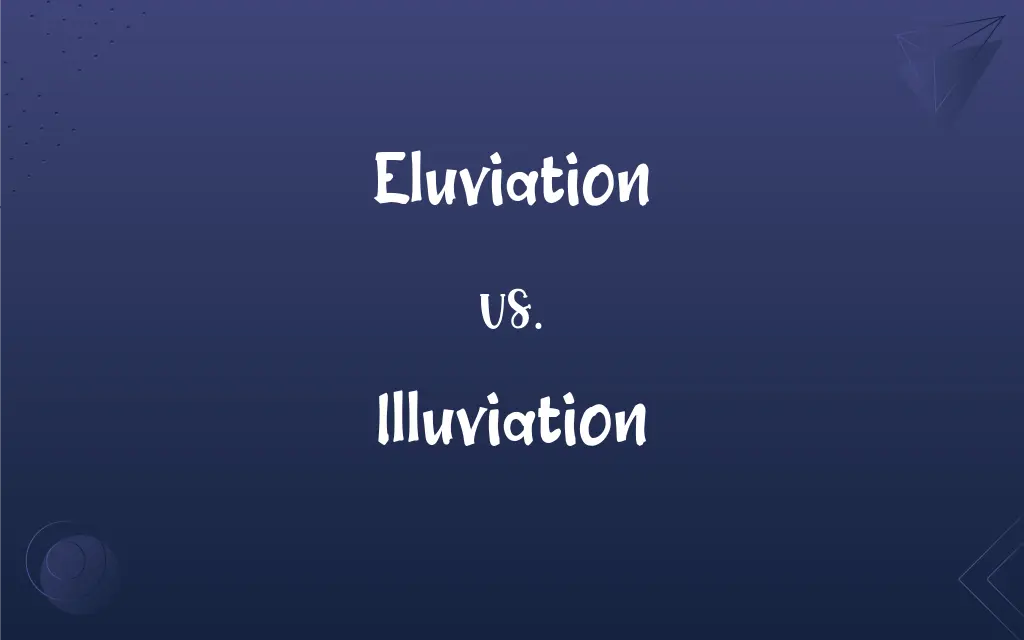Eluviation vs. Illuviation: What's the Difference?
Edited by Harlon Moss || By Janet White || Updated on October 5, 2023
The process of leaching, where minerals and organic matter are washed out of a soil layer. The process where the leached materials from eluviation are deposited in a lower soil layer.

Key Differences
Eluviation and Illuviation denote two contrasting processes within soil science, particularly in pedology, the study of soil formation. While eluviation refers to the washing out or leaching of minerals, soluble compounds, and organic matter from a soil layer, illuviation is its counterpart, referring to the accumulation or deposition of materials, often in a lower layer, that have been transported through the process of eluviation.
Understanding eluviation is vital to grasping soil structure, fertility, and health. This process, while a natural occurrence, tends to strip a soil layer of essential nutrients and minerals. The eluviated materials include ions, clay particles, organic matter, and other solubles which get washed away typically by percolating water, leaving behind a layer significantly altered and often lighter in color due to the leaching of iron or aluminum oxides.
Conversely, illuviation represents the deposition phase following eluviation. Materials carried away from the upper or above layer through eluviation are deposited into another layer beneath, which could be observed as a layer rich in specific compounds or elements, such as iron, aluminum, or calcium. It's crucial to recognize that illuviation does not only refer to the movement of particles through the soil but importantly to their accumulation in a new horizon, significantly impacting its color, structure, and functionality.
The implication of eluviation on agriculture and plant growth can be substantive, as the nutrient depletion in the eluviated layer might impair the growth of vegetation, altering the nutrient availability to plants. Whereas, illuviation, resulting in the accumulation of certain materials in a lower layer, may obstruct the downward movement of water, roots, and other organisms, often resulting in a compacted or dense layer, which might create challenges for deep-rooting plants.
It is vital to perceive eluviation and illuviation as interconnected, sequential processes within the soil profile. Eluviation, with its leaching action, directly facilitates illuviation, through the transportation of materials to a lower horizon where they accumulate. Both processes together play a pivotal role in the development of soil horizons and consequently impact the structure and composition of soils, steering the establishment and success of overlying ecosystems.
ADVERTISEMENT
Comparison Chart
Definition
The removal of dissolved ions, clay particles, and organic matter from a soil layer.
The accumulation of dissolved ions, clay particles, and organic matter in a soil layer.
Direction of Movement
Moves materials upwards or out of a soil layer.
Moves materials downwards into a deeper soil layer.
Effect on Soil Layer
Often leaves a lighter, leached layer, called an eluvial horizon.
Leads to a darker, enriched layer, known as an illuvial horizon.
Associated Horizons
Commonly associated with the E horizon (eluviated horizon) in soil profiling.
Commonly associated with the B horizon (illuviated horizon) in soil profiling.
Impact on Soil Nutrients
Can decrease soil fertility by removing nutrients from the layer.
Can increase fertility in the deposition layer due to the accumulation of materials.
ADVERTISEMENT
Physical Appearance
Can cause a layer to appear lighter or whitish due to the leaching away of materials.
Can cause a layer to appear darker due to the accumulation of organic materials or minerals.
Relation to Water Movement
Involves the movement of water downwards, leaching away materials.
Involves the movement of water and the subsequent deposition of materials from above.
Eluviation and Illuviation Definitions
Eluviation
Eluviation refers to the transport of soil material from upper layers to lower layers through water movement.
Through eluviation, the topsoil lost its minerals, impacting plant growth adversely.
Illuviation
It typically results in an illuvial horizon, which is richer in certain materials, like silicate clay, iron, or aluminum.
The illuvial horizon was evident with its darker, clay-enriched layer, formed through illuviation.
Eluviation
Eluviation often results in a visibly paler and less fertile eluvial horizon due to the removal of materials.
The E horizon demonstrates eluviation by displaying a whitish or light-colored layer in the soil profile.
Illuviation
Illuviation is crucial in soil development, impacting nutrient availability and soil structure.
Illuviation significantly influences the subsoil properties by accumulating leached materials and altering its composition.
Eluviation
It is a soil-forming process that involves the removal of dissolved ions and/or fine particles, leaving a leached layer.
Eluviation played a vital role in developing the lighter horizon by leaching away iron compounds.
Illuviation
The process of illuviation involves the movement and deposition of materials such as clay, iron, or organic matter within the soil.
Iron illuviation resulted in a distinct, reddish-brown layer in the subsoil, enhancing its fertility.
Eluviation
Eluviation can occur alongside illuviation, impacting the physical and chemical properties of different soil horizons.
The downward movement of water facilitated eluviation, stripping the soil of its calcium content.
Illuviation
Illuviation often occurs in tandem with eluviation, with materials moving from an eluvial to an illuvial horizon.
The silty layer beneath the topsoil is a result of illuviation, where fine particles have accumulated.
Eluviation
In eluviation, the solubility and mobility of materials are crucial in determining what is leached away.
Silica eluviation shaped the soil properties by leaching soluble compounds and leaving behind a silica-rich layer.
Illuviation
Illuviation is the process where particles and solutes are deposited in a lower soil layer from an above layer.
Illuviation caused the accumulation of leached materials, darkening the soil layer below the eluvial horizon.
Eluviation
The lateral or downward movement of dissolved or suspended material within soil when rainfall exceeds evaporation.
Illuviation
The deposition in an underlying soil layer of colloids, soluble salts, and mineral particles leached out of an overlying soil layer.
Eluviation
The sideways or downward movement of dissolved or suspended material within soil caused by rainfall
Illuviation
(geology) The accumulation of suspended material and soluble compounds leached from an overlying stratum
Eluviation
Creation of geological deposits (eluvial deposits) by in situ weathering or weathering plus gravitational movement or accumulation.
FAQs
How does illuviation affect the soil profile?
Illuviation affects the soil profile by depositing leached materials, often forming a darker, enriched layer in the subsoil.
Can eluviation and illuviation happen simultaneously?
Yes, eluviation and illuviation often occur concurrently, with materials moving from eluvial to illuvial horizons within the soil.
What materials typically accumulate due to illuviation?
Illuviation typically results in the accumulation of materials like silicate clay, iron, or aluminum oxides in a lower soil horizon.
Is eluviation responsible for soil lightening or darkening?
Eluviation usually causes soil lightening, as it involves the leaching away of materials, often leaving behind a paler layer.
What does eluviation involve in terms of soil?
Eluviation involves the removal or leaching of materials, such as minerals and organic matter, from one soil layer to another.
How does eluviation affect soil fertility?
Eluviation often reduces soil fertility in the leached layer due to the removal of nutrient-rich materials.
Which scientific field studies processes like eluviation and illuviation?
Pedology, a branch of soil science, studies processes like eluviation and illuviation within soil profiles.
What is the result of eluviation in soil horizons?
The result of eluviation is usually an eluvial horizon (often labeled E), which is characterized by being lighter and often less fertile.
What impact does illuviation have on nutrient availability in soil?
Illuviation can enhance nutrient availability in the deposition layer by accumulating minerals and organic matter.
What are some physical signs of eluviation in soil?
Physical signs of eluviation might include a lighter, often grayish or whitish soil layer, indicating leaching.
Is illuviation related to certain soil colors?
Yes, illuviation can result in specific soil colors, such as reddish-brown due to iron accumulation or grayish due to clay movement.
Which horizon is often associated with illuviation?
The B horizon in soil profiling is commonly associated with illuviation, as it accumulates leached materials from above.
Can eluviation happen in all types of soil?
While it can occur in various soils, eluviation is more pronounced in certain types, like those prone to high water movement.
Can human activities influence eluviation?
Yes, activities like irrigation or any practice that alters water movement in soil can influence eluviation.
How do climatic conditions affect illuviation?
Climatic conditions, especially precipitation, influence illuviation by affecting water movement and leaching within the soil.
How do eluviation and illuviation contribute to soil layer differentiation?
Eluviation and illuviation contribute by leaching materials from one layer and depositing them in another, creating distinct horizons.
What factors influence illuviation in soil?
Factors like rainfall, soil texture, and the presence of leachable materials influence illuviation.
Does illuviation always lead to nutrient-rich layers?
Not always; the nutrient content in illuvial layers depends on the specific materials being transferred and deposited.
What is the primary mover of materials in eluviation?
Water is the primary mover, facilitating the leaching and transportation of materials through the soil.
Are eluviation and illuviation reversible processes?
While the processes per se are not directly reversible, certain soil management practices can modify the horizons impacted by eluviation and illuviation.
About Author
Written by
Janet WhiteJanet White has been an esteemed writer and blogger for Difference Wiki. Holding a Master's degree in Science and Medical Journalism from the prestigious Boston University, she has consistently demonstrated her expertise and passion for her field. When she's not immersed in her work, Janet relishes her time exercising, delving into a good book, and cherishing moments with friends and family.
Edited by
Harlon MossHarlon is a seasoned quality moderator and accomplished content writer for Difference Wiki. An alumnus of the prestigious University of California, he earned his degree in Computer Science. Leveraging his academic background, Harlon brings a meticulous and informed perspective to his work, ensuring content accuracy and excellence.































































